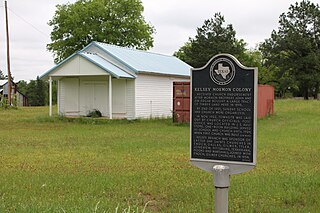Related Research Articles

Smith County is a county in the U.S. state of Texas. As of the 2010 census, its population was 209,714. Its county seat is Tyler. Smith County is named for James Smith, a general during the Texas Revolution.

Cherokee County is a county located in the U.S. state of Texas. As of the 2010 census, its population was 50,845. The county seat is Rusk. The county was named for the Cherokee, who lived in the area before being expelled in 1839. Rusk, the county seat, is 130 miles southeast of Dallas and 160 miles north of Houston.

Bullard is a small town in Smith and Cherokee Counties in the east-central part of U.S. state of Texas. U.S. Route 69 and Farm-to-Market Roads 2137, 2493, and 344 intersect here, about 15 miles (24 km) south of the larger city of Tyler. Its population was 2,463 at the 2010 census, up from 1,150 at the 2000 census.

La Réunion was a utopian socialist community formed in 1855 by French, Belgian, and Swiss colonists on the south bank of the Trinity River in central Dallas County, Texas (US). The colony site is a short distance north of Interstate 30 near downtown Dallas. The founder of the community, Victor Prosper Considerant, was a French democratic socialist who directed an international movement based on Fourierism, a set of economic, political, and social beliefs advocated by French philosopher François Marie Charles Fourier. Fourierism subsequently became known as a form of utopian socialism.

Independence is an unincorporated community in Washington County, Texas, United States. Located twelve miles northeast of Brenham, it was founded in 1835 in Austin's colony of Anglo-Americans. It became a Baptist religious and educational center of the Republic of Texas. In 1845 it became the first site of Baylor University and the University of Mary Hardin-Baylor.
Etna is a ghost town that was located near the site of present-day Bullard in northwestern Cherokee County, Texas, United States.

Kelsey is an unincorporated area in Upshur County, Texas, United States that was the longest-lasting settlement founded by members of The Church of Jesus Christ of Latter-day Saints in the state. Now a ghost town, it has been called the "mother colony" of Latter-day Saint colonies in Texas.
Colfax was a short-lived communal farming community—now a ghost town–in Fremont County, Colorado Territory, United States. It was named after Vice President Schuyler Colfax.

Rosharon, also known as "Buttermilk Station," is an unincorporated community and census-designated place (CDP) in Brazoria County, Texas, United States, at the intersection of Farm to Market Road 521 and Farm to Market Road 1462. As of the 2010 census, it had a population of 1,152.

Candelaria is an unincorporated community in Presidio County, Texas, United States, with about 75 inhabitants.

Saint John Colony is an unincorporated community in Caldwell County, Texas, United States. According to the Handbook of Texas, the community had a population of 150 in 2000. It is located within the Greater Austin metropolitan area.
Farm to Market Road 344 is a 18.126-mile (29.171 km) farm to market road located in Smith County, Texas.

Pedernales, Texas was an early settlement of German immigrants in Gillespie County, and was part of the Adelsverein colonization of Texas. No trace of the settlement remains today. It was located 7 miles (11 km) southwest of Fredericksburg near what is now Texas State Highway 16. The Pedernales school received a Texas Historical Commission Subject Marker in 1993, Marker number 10095.

Eckert is a ghost town, 11.5 miles (18.5 km) northeast of Fredericksburg in Gillespie County, in the U.S. state of Texas. West of Willow City, on FM 1323, Eckert is at the junction of State Highway 16.

Estacado is a ghost town in Crosby and Lubbock Counties in the U.S. state of Texas. Located along Farm to Market Road 1527, it was established in 1879 as a Religious Society of Friends (Quaker) colony by Paris Cox and originally named Maryetta after his wife. In 1886, it became the first government seat of Crosby County. In 1936, Recorded Texas Historic Landmark number 4779 was designated to commemorate the founding of Estacado.

Larissa is a rural community and abandoned townsite in northwestern Cherokee County, Texas, United States. Larissa lies west of US Highway 69, off Farm Road 855 and approximately halfway between Jacksonville and Bullard. Larissa is about 20 miles (32 km) northwest of the county seat of Rusk.

Cuthbert is a ghost town in Mitchell County, Texas, United States. Cuthbert was established in 1890 when the founder D. T. Bozeman built a wagonyard and store. The community and post office were named for Thomas Cuthbertson, a family friend of the Bozemans. By the early 1920s, Cuthbert had a church, two stores, a blacksmith shop, a cotton gin, telephone office, and a school. In 1920 the T. and P. Abrams No. 1 oil well, one of the first commercial oil ventures in the Permian Basin, was drilled just over a mile north of the town. A post office, two businesses, and a population of twenty-five were reported at the community in 1936, the year that its school was consolidated with that of Colorado City. After World War II the improvement of rural roads in the area led to Cuthbert's decline as it lost its trade to Colorado City. The Cuthbert post office was discontinued about 1960, when the town reported one business and a population of twenty-five. By 1974 only a cemetery and scattered farms remained in the area.
Template:Infobox Nondenominational

College Mound is an unincorporated community in Kaufman County, located in the U.S. state of Texas. It is on the Wikipedia List of ghost towns in Texas.
References
- 1 2 3 4 "Burning Bush, Texas". Geographic Names Information System . United States Geological Survey.
- ↑ Baker, T. Lindsay (1986). Ghost Towns of Texas. Norman: University of Oklahoma Press. pp. 16–18. ISBN 0806121890.

